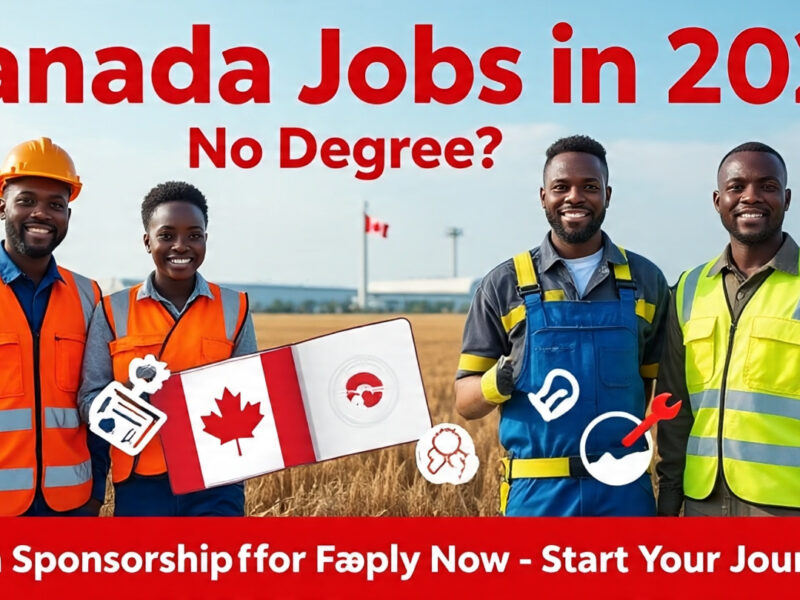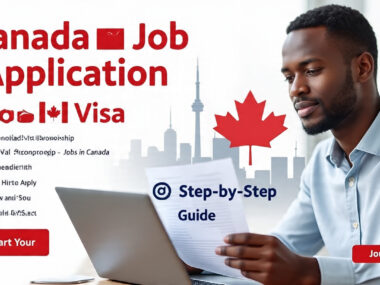Many believe migrating to Canada requires a university degree—and significant debt. The truth? While skilled-aligned programs exist, there are countless visa sponsorship jobs in 2025 that do not require a degree. Canada’s economy is hungry for workers in agriculture, hospitality, warehousing, construction, and caregiving. These opportunities include employer-provided LMIA work permits and even pathways to permanent residency through PNP streams.
This article covers:
-
High-demand jobs you can land without a degree
-
Visa sponsorship options for unskilled and semi-skilled roles
-
A step-by-step application guide to help you succeed
-
SEO-friendly keyword insights to improve your site’s monetization
No degree? No problem. Let’s begin.
Why Canada Needs Degree-Free Workers in 2025
-
Post-pandemic shortages hit non-degree sectors hardest: farms, hotels, restaurants, warehouses
-
Immigration goals still pushing over 500,000 new permanent residents annually, including non-grads
-
Provincial Nominee Programs (PNPs) regularly invite caregivers, truck drivers, and hospitality staff with no degree
-
Employer confidence is rising—many willing to invest in on-the-job training and visa paperwork
High-Demand Jobs That Don’t Require Degrees (All Sponsored)
1. Warehouse Worker & Forklift Operator
-
Salary: CAD 40K–60K/year
-
Why in demand: Surge in e-commerce logistics
-
Visa route: LMIA work permit → PNP for PR in provinces like Manitoba, Saskatchewan
2. Food Processing & Meat Plant Worker
-
Salary: CAD 38K–50K/year
-
Why in demand: Ongoing need for meat packers, vegetable sorters
-
Visa route: LMIA (Agri-Food Pilot option) → potential PR via pilot after 6 months
3. Farm Labour & Seasonal Assistant
-
Salary: CAD 30K–45K/year (+room & board)
-
Visa route: SAWP (Seasonal Agricultural Worker Program) or LMIA
-
Bonus: Quick starts, employer-arranged housing
4. Housekeeping & Hotel Staff
-
Salary: CAD 30K–45K/year
-
Why in demand: Post-pandemic tourism bounce
-
Visa route: LMIA-backed work permit
5. Construction Labourer
-
Salary: CAD 45K–65K/year
-
Why in demand: National infrastructure boom
-
Visa route: LMIA → PNP streams for labor-intensive roles
6. Food Service Worker (Dishwasher, Server)
-
Salary: CAD 30K–45K/year (+ tips)
-
Visa route: LMIA → hospitality-specific PNP streams
7. Caregiver / PSW
-
Salary: CAD 38K–50K/year
-
Visa route: LMIA or Home Caregiver Pilot for defined care jobs
Visa Sponsorship Options for Non-Degree Workers
LMIA-Based Work Permits
An LMIA (Labour Market Impact Assessment) verifies that no Canadian is available for the job; once approved, the employer sponsors your permit.
Agri-Food Pilot & SAWP
Designed for temporary farm and food processing workers—employer-driven with minimal requirements and potential PR after work.
PNP Entry Routes
Many provinces allow laborer-focused streams that don’t require degrees—perfect for long-term settlement.
Step-by-Step Guide: How to Apply & Get Hired
Step 1 – Choose Your Role & Visa Program
Pick a job that matches your physical ability, interest, and location preference (e.g., BC farm, Ontario warehouse).
Step 2 – Build a Canadian-Style Resume
-
One page, clear headings
-
Highlight reliability, languages, and soft/physical skills
-
Add any certificates (e.g., forklift, food safety) if possible
Step 3 – Search for LMIA-Backed Job Listings
-
Use trusted portals: Job Bank, Indeed.ca, specific employer sites
-
Filter by “LMIA,” “Visa sponsorship,” or “Employer-provided”
Step 4 – Apply & Prepare for Virtual Interviews
-
Emphasize traits like punctuality, team spirit, and relocation readiness
-
Ask where they’d like you to start and when
Step 5 – LMIA & Work Permit Application
-
Employer submits LMIA (cost approx. CAD 1,000)
-
You apply for a work permit—processing takes 1–3 months
Step 6 – Prepare to Move
-
Employer may arrange accommodation
-
Get informed about Canadian labor rights and settling essentials
Step 7 – Work & Explore PR Pathways
-
After a year, many workers become eligible for PNP fast tracks
-
Temporary roles can transition into permanent residency
Watch Out for Scams & Pitfalls
-
Never pay to apply—legitimate jobs don’t require payments
-
Verify employers via Canada.ca or Job Bank
-
Scrutinize vague ads that lack remuneration or employer details
-
Use migrant rights sites for info on work permit restrictions and protections
Final Takeaway: Your Path Without a Degree
Canada’s 2025 economy needs non-degree foreign workers—and offers legal, salaried paths with visa sponsorship. Whether you’re cleaning hotel rooms, harvesting produce, or operating machinery, these roles can be your ticket:
-
Pick a suitable job that aligns with your strengths
-
Craft a tailored resume
-
Apply for LMIA-sponsored positions
-
Secure your work permit and relocate
-
Work smart and qualify for PR streams
No degree? No problem. Your journey to Canada starts now—with preparation, persistence, and the right strategy.






